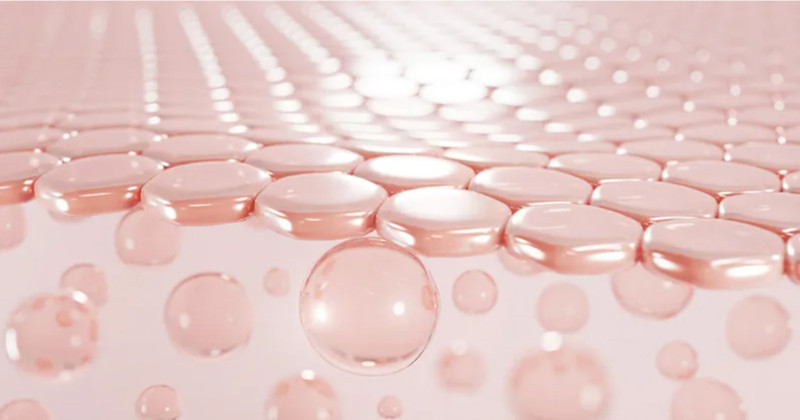Collagen synthesis

The process by which our body produces collagen is collagen synthesis. Without it, our bones, cartilage, tendons and skin would lack elasticity, strength and structure. This important synthesis takes place continuously in various tissues, but decreases with increasing age. In this blog post, you can find out exactly how the process works and how you can support it to maintain collagen production for a healthy body and skin.
Table of content
- 1. Collagen synthesis - what's behind it?
- 2. Where does collagen synthesis take place?
- 3. How collagen synthesis works
- 4. Boosting collagen synthesis?
Collagen is a protein that is found in our body and plays an important role in the structure and strength of our skin, bones, cartilage and tendons. As we age, the production of collagen in our body decreases, which can lead to a loss of elasticity and firmness in the skin. In this blog post, we will take a closer look at collagen synthesis and how to improve it.
Collagen synthesis - what's behind it?
Collagen synthesis is the process by which our body produces collagen. It is produced by specialized cells called fibroblasts. These are located in the dermis, i.e. the middle layer of the skin. The process of collagen synthesis is relatively complex and involves several steps, which we will discuss below.
Where does collagen synthesis take place?
Collagen synthesis takes place in various tissues of the body. More specifically, collagen is formed in the extracellular matrix of bone, cartilage and skin. The cells responsible for collagen synthesis belong to the following cell types:
- Fibroblasts: These cells are found in the skin and connective tissue and produce collagen to maintain the structure and strength of these tissues.
- Chondroblasts : Chondroblasts are found in the cartilage tissues and produce collagen to ensure the strength and elasticity of the cartilage.
- Osteoblasts: These cells are found in the bones and produce collagen to maintain the structure and strength of the bones.
- Smooth muscle cells: So-called smooth muscle cells are found in the blood vessels and produce collagen to ensure the strength and elasticity of the vessel walls.
Collagen synthesis takes place within the cells and is then exported to the extracellular matrix (EC M), where the collagen molecules form a network that gives tissues their structure and strength. The ECM is an important component of the connective tissue that connects and supports different tissues in the body.
How collagen synthesis works
The first step in collagen synthesis is the formation of procollagen. Procollagens are precursors of collagen that are formed from amino acids. These procollagens are then folded into a triple helix structure and released. In a further step, the procollagen molecules are converted into collagen molecules by enzymes and finally incorporated into the extracellular matrix.
The individual steps of collagen synthesis:
- Transcription
Collagen synthesis begins with the transcription of DNA into RNA. The gene for collagen is activated in the cell and an mRNA copy is created. - Translation
The mRNA is transported from the cell nucleus into the cytoplasm, where it serves as a template for the synthesis of collagen. Ribosomes (responsible for protein synthesis) read the mRNA and assemble the amino acids in the correct sequence. - Formation of procollagen
The amino acid chain that is synthesized from ribosomes is called procollagen. This precursor molecule consists of three peptide chains that are intertwined in a helical structure. - Processing
Procollagen is transported into the endoplasmic reticulum (ER), where it undergoes further modifications. The peptide chains are chemically modified and the helical structure is stabilized - Transport
Procollagen is exported from the ER and passed through the Golgi apparatus where it is further processed. Here, procollagen is converted into collagen molecules by cutting off the peptide chain. - Release
The finished collagen molecules are released from the cell and incorporated into the extracellular matrix (ECM). Here they form a network that gives the cell structure and strength.
Collagen synthesis is a continuous process that can be influenced by various factors. For example, nutrition, hormones, age and environmental conditions all play a role. By optimizing these factors, we can help support collagen synthesis and keep our skin and body healthy.
Boosting collagen synthesis?
There are several ways to improve collagen synthesis. One way is to supply the body with nutrients that are important for collagen synthesis. These include, for example, vitamin C, which helps in the formation of procollagen, and amino acids such as glycine and proline, which are important for the formation of collagen molecules. Many studies have confirmed that collagen supplements have a demonstrably positive effect.
A collagen shot, which contains the optimum amount of essential vitamins, is ideal for this. The highly concentrated, liquid food supplement collagen shot with vitamin D3 and turmeric is also particularly popular.
Another option is to support the skin with external products that stimulate collagen synthesis. These include topical products such as retinol, which stimulates collagen production, and peptides, which can increase the production of collagen and elastin. In order to offer your skin a truly healthy, rich skincare experience, you should opt for natural cosmetics. Hyaluronic face cream and hyaluronic body lotion are suitable for this.
As mentioned, a healthy lifestyle that includes regular exercise, sufficient sleep and a balanced diet can also help to improve collagen synthesis. Smoking and excessive alcohol consumption, on the other hand, can impair collagen synthesis and should be avoided. Collagen synthesis is an important process that is crucial for the health of our skin, bones, cartilage and tendons. By providing our bodies with the right nutrients, using topical products and maintaining a healthy lifestyle, we can help to support collagen synthesis and improve the appearance of our skin and body in general.
